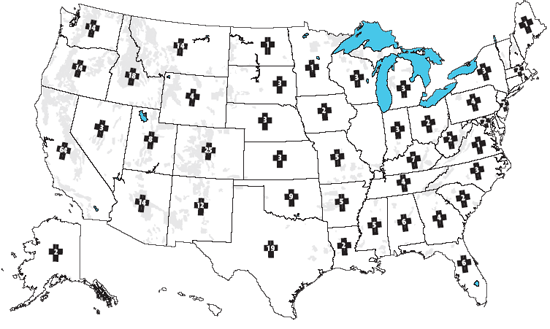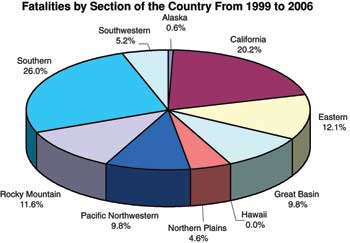Locations of Fatalities
During the period covered by this study, all but 7 of the 50 United States had fatalities during wildland fire operations (figure 12). During the initial study period, 137 persons died in 33 States (15.2 fatalities per year). During the most recent period, 173 persons died in 41 States (21.6 fatalities per year).
Fatalities During Wildland Fire Operations, 1990 to 2006
310 Total

Figure 12—All but seven
States had fatalities during
wildland fire operations from
1990 to 2006.
The "Safety Gram" identifies fires by State. The following groups of States were used to provide an overview of fatalities for different sections of the country (figure 13).
- Hawaii—(There were no fatalities in this State during the entire
period.)
- Alaska
- California
- Pacific Northwestern States—Oregon, Washington
- Rocky Mountain States—Colorado, Kansas, Nebraska, South Dakota,
Wyoming
- Northern Plains States—Montana, North Dakota
- Great Basin States—Idaho, Nevada, Utah
- Southwestern States—Arizona, New Mexico
- Southern States—Alabama, Arkansas, Florida, Georgia, Kentucky, Louisiana,
Mississippi, North Carolina,
Oklahoma, South Carolina, Tennessee, Texas, Virginia
- Eastern States—Connecticut, Delaware, Illinois, Indiana, Iowa, Maine, Maryland, Massachusetts, Michigan, Minnesota, Missouri, New Hampshire, New Jersey, New York, Ohio, Pennsylvania, Rhode Island, Vermont, West Virginia, Wisconsin
 |
 |
 |
Figure 13—One in five fatalities during wildland
fire operations from 1990
to 2006 was in California.
California was the State with the largest number of fatalities, 64 (3.8 fatalities per year). Fatalities in California increased from 29 during the initial period (3.2 fatalities per year) to 35 in the most recent period (4.4 fatalities per year), a 36-percent increase in the annual average. The California incident with the largest number of fatalities was the October 2006 Esperanza Fire that killed five Federal firefighters during a burnover.
Other States with large numbers of fatalities were: Colorado (25 fatalities, including 14 from the 1994 South Canyon Fire and 5 in the 2002 Grayback Forestry vehicle rollover), Texas (19 fatalities, including 11 during the most recent period); Idaho (18 fatalities, including 11 during the most recent period—four in a single aircraft crash). Washington, Oregon, Montana, and Arizona had 14 fatalities each. New Mexico had 12 fatalities. Other States had no more than 10 fatalities during the entire period.
Fatalities in the Southern States increased from 28 during the initial period (3.1 fatalities per year) to 45 during the most recent period (5.6 fatalities per year), an 81-percent increase in the annual average. Within this section of the country, seven States (Mississippi, Florida, Tennessee, North Carolina, Texas, Arkansas, and Kentucky) had a large increase in fatalities from the initial period (14, 1.6 per year) to the most recent period (35, 4.4 per year). The large increase in fatalities in the Southern States might be driven in part by drought conditions responsible for large increases in the number of fires and the acres burned.
In the Pacific Northwestern States, fatalities increased from 11 (1.2 fatalities per year) during the initial period to 17 (2.1 fatalities per year) during the most recent period. The large increase in this area was due to eight fatalities in the First Strike Environmental vehicle accident.
The Eastern States had the third largest percentage increase in fatalities, from 14 during the initial period (1.6 fatalities per year) to 21 during the most recent period (2.6 fatalities per year), a 69-percent increase in the annual average. This increase is not due to any single event, but to a combination of events across the region.
Overall, fatalities in the Great Basin States increased from 12 during the initial period (1.3 fatalities per year) to 17 during the most recent period (2.1 fatalities per year). Idaho had 7 fatalities during the initial period (0.8 fatalities per year) and 11 fatalities during the most recent period (1.4 fatalities per year).
The Southwestern States had a meaningful drop in fatalities: from 17 fatalities during the initial period (1.9 fatalities per year) to 9 fatalities during the most recent period (1.1 fatalities per year), a decrease of 40 percent in the annual average. The initial period included six fatalities on the Dude Fire in 1990.
The Northern Plains and Rocky Mountain States experienced moderate increases in fatalities during the most recent period. In the Northern Plains States, fatalities were up 14 percent, from 7 (0.8 fatalities per year) to 8 (1.0 fatality per year). In the Rocky Mountain States, fatalities were up 11 percent, from 18 (2.0 per year) to 20 (2.5 per year).


